School: Tauhara College, Taupo
Bright Spots team members: James Lamb (HOF Science), Kris Watson (HOF Technology) and Dan Piper (Senior Math and Year 9 Dean).
Bright Spots Team Contact Email: wn@tauhara.school.nz (Kris), lj@tauhara.school.nz (James)
Year levels: Years 9 and 10
Curricular area(s): Science, mathematics and technology
Broad area of focus: Engagement and motivation in STEM subjects
The specific focus of our project: To actively engage reluctant and unmotivated students in STEM subjects using the Design Thinking Process applied to real world problems.
Why this focus was important
James, Kris and Dan were concerned by how few students, especially Māori girls, participated in Science, Technology, Engineering and Mathematics (STEM) subjects. They were also concerned that siloed delivery of each of mathematics, science and technology was not capitalising on the natural and fruitful connections between the subjects.
Taking action
The Bright Spots Award funded the team to pilot the approach over the 2019 and 2020 school years. The project was also supported by the Ministry of Education PLD funding. This enabled Jim Hogan (ACC 572), an experienced STEM practitioner, to work as a part-time mentor and facilitator for the team.
2019
Using the overarching whakatauki – He waka eke noa – We’re all in this together – the project was inspired by stories of early Māori explorers and these stories were used to emphasise the importance of exploration, taking risks and working as a team. For one class of 30 Year 9 students the separate subjects were integrated around problems in the local community, introduced to the students by members of stakeholder groups in the community. The students were selected using an application process in which they shared their passions and learning preferences during the normal school enrolment process. The teacher role shifted from teacher-led direct instruction to facilitation of collaborative group work.
The STEM Hub consists of an original wing of a traditional school block which was altered to include two classrooms, a boardroom, office and ICT space to ultimately become a Modern Learning Environment with a ‘makerspace’ design style.
The curriculum for the year was organised around four units. In each unit students were set the challenge of solving a different real-world problem posed by the community. Each real-world problem was carefully evaluated by the teaching team to ensure curriculum coverage. The four units of work were:
- Predator Free Waitahanui. In this unit, students were challenged to design and create a rat trap capable of killing more than one rat. This project allowed students to explore key scientific concepts from the living world strand including ecological adaptation and interdependence while gaining an awareness of conservation issues relating to the Predator Free 2050 initiative. They also used geometry from the maths curriculum in the process of designing their traps.
- UNISON Light Display at the Taupo Winter Festival. This unit became part of an exhibition of light installations and sculptures that takes place during the Taupo Winter Festival, for which students created a kinetic light sculpture. The brief specified that the sculpture should have moving parts, so the students designed pedal-powered dynamos. The sculptures also needed to be made from recycled materials, which allowed students to explore important concepts in Design Technology such as sustainability. They also considered the issue of global warming in relation to the festival’s ‘magic of winter’ theme.
- Havoc Traffic. In this unit students explored the ‘Kiss and Drive Zone’ at a local primary school which had created high density traffic and safety concerns. A better management plan was requested in collaboration with Police, Transport Agency and a local primary school principal. As part of the unit, students collected data to produce a road safety video with the aim of an improved traffic management plan.
- Te Waka Time Machine. In the final term, students chose a real-world problem of their own to solve. The focus of projects varied from creating a BMX from recycled parts to the development of a student-led Tauhara College radio station.
Each term’s project was developed using the Design Thinking process. At the beginning of the term, a stakeholder introduced a situation and issues that formed the basis for students developing their real world problem. In the Havoc Traffic project, for example, a local Police Officer and primary school principal came to the class to outline the situation. The class then co-constructed the real world problem to explore, formed teams, and started the learning journey to discover possible solutions. The learning journey followed three key phases:
- Explore. Students work with a Stakeholder to develop empathy for and a better understanding of the issue preparatory to defining a specific real-world problem.
- Discover. Students conduct deeper research into the problem and begin to identify and develop potential conceptual designs.
- Innovate. Students choose a final concept, which is then developed into a working prototype. This is tested and trialled to determine the project’s effectiveness against a co-constructed set of specifications (success criteria). Finally, a working prototype is presented to the stakeholder, local experts, whānau and staff members. This all takes place in the class boardroom (see photo below). Incentives are awarded to the best solutions.
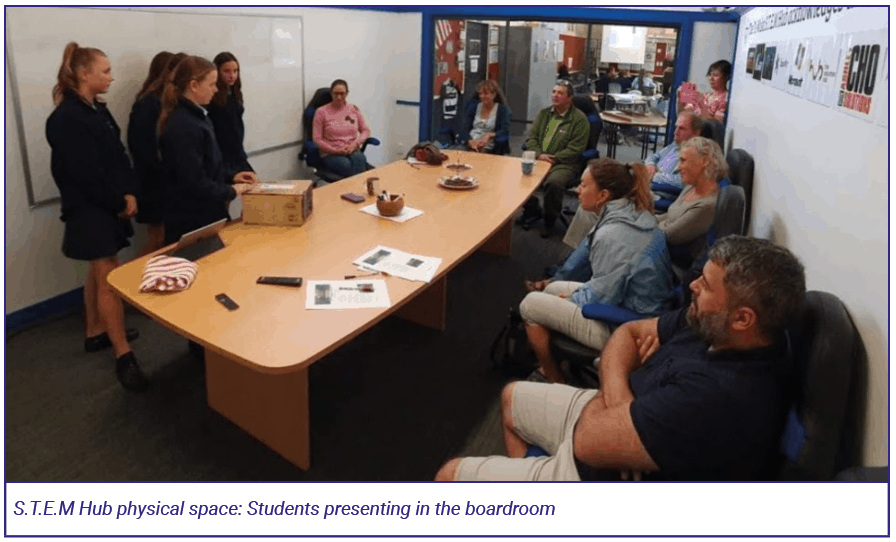
2020
Learning from 2019 informed changes implemented for the 2020 programme. The programme followed the Year 9 cohort into Year 10. The number of units of work was reduced from four to two to allow for more depth of learning and student knowledge construction. The original intention had been to reduce from four units to three, but the impact of lockdown led to a further reduction to two units. The programme was also introduced to two new Year 9 classes.
The Year 10 units of work selected were:
- Survivor Taupo. This involved students working with Civil Defence to build a deep understanding of the volatile nature of the Central Plateau and the risks this presents. This involved the science curriculum areas relating to planet earth, such as interacting systems and plate tectonics, as well as heat transfer. The project led to the real world problem of developing a portable cooking device suitable for use in emergency situations.
- Tauhara Take-Off. This involved students working alongside the new Principal of Tauhara College, Ben Hancock, who suggested the need for an exciting and exhilarating promotional video to support the enrolment process for 2021 under the title of ‘Come to Tauhara College and let your learning journey take off!’. Video footage from approximately 200 metres above the school grounds was captured and used in this promotion. It involved a study of rocketry and the Physical World component of the science curriculum.
We also made a change to the composition of the STEAM teams. In 2019 we allocated 6 students to a team but realised that this was too many to keep them all actively involved. So recently we reduced the team size to three with each student taking on two roles. One role was either the CEO (reporting progress and developing strategy), narrator (recording the journey – video, photo, writing; deciding on the approach to the stakeholder) or marketer (branding and costing). The other role was either the designer (collecting the ideas, drafting the designs), science expert or engineering expert. Mathematics was embedded throughout these roles. Students negotiated the allocation of roles amongst themselves according to the focus of the project. While they each had roles, in practice they worked together on everything.
Engaging in new professional learning
The team developed their ability to critically reflect, approach all tasks in an agile manner and consistently develop resources and approaches to provide a fresh and evolving model of teaching and learning. This is demonstrated by the adaptation of the Design Thinking learning process (see current design of the process below). The most significant change was the evolution of the concept-development stage into a much more iterative process comprising key content input (for example, electricity and electronics for the Predator Free experience, heat transfer for the civil defence portable cooker experience) to support student question-generation and the discovery of possible solutions that could then be tested, trialled and presented back to stakeholders.
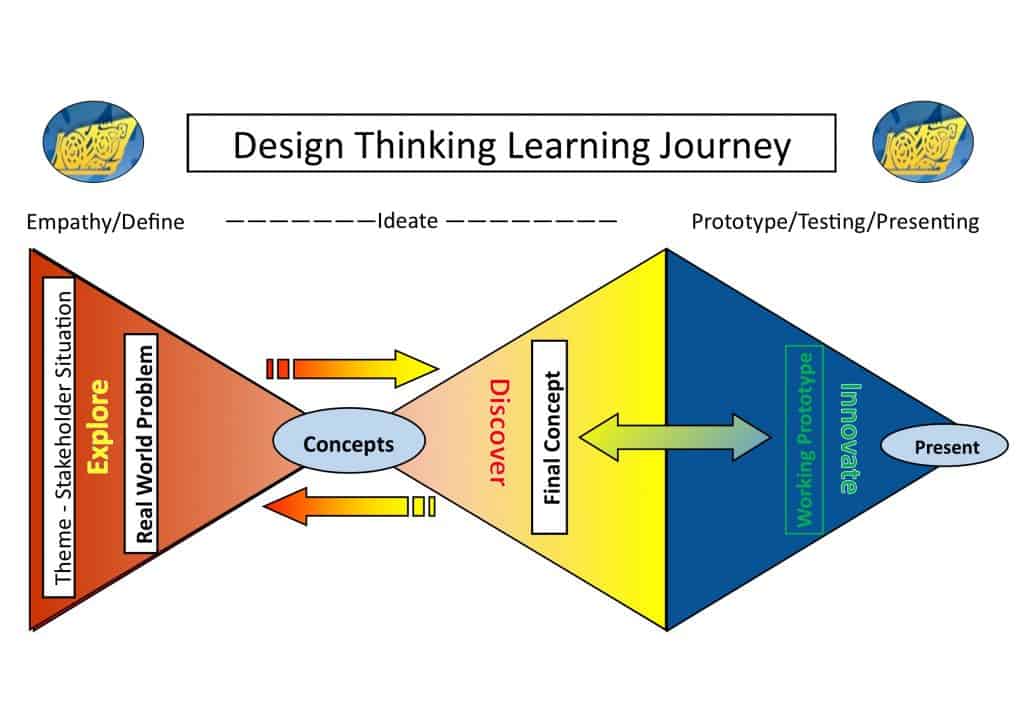
The team adapted the Innovative Teaching and Learning Future Focused Skills rubric into a student-friendly matrix to support opportunities for self-, teacher- and co-constructed assessment. Level 5 on the rubric was designed to describe the dispositions most strongly aligned to future success in NCEA in STEM subjects. Thus, supporting students to progress to this level in their Design Thinking learning journeys was an important consideration.
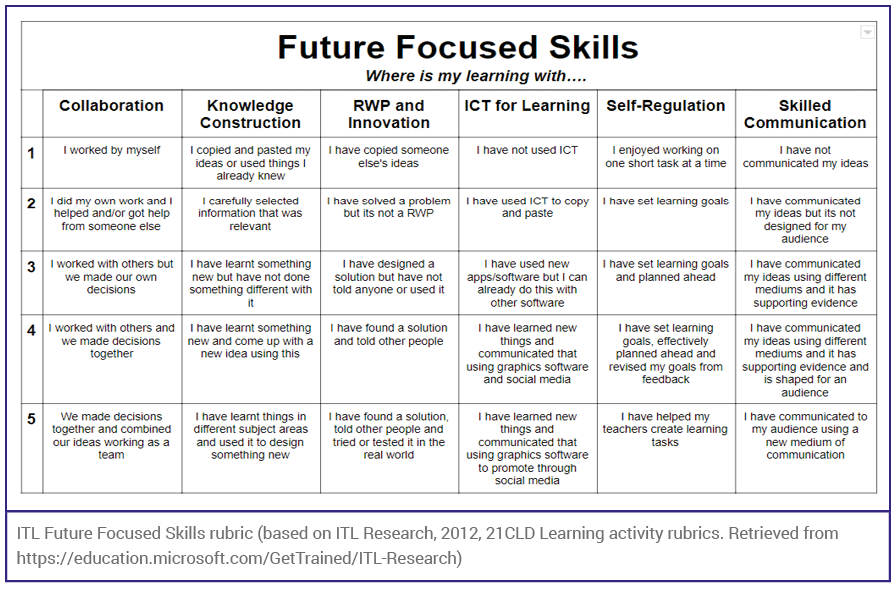
The team made significant changes to their pedagogy as a result of adopting a project-based learning approach, so that what was previously teacher-driven became mostly student-driven. Students and teachers were guided by the realisation that learning is more important than a focus on just finding the correct answer, and that failures are opportunities to provide future learning. This was reinforced by using surveys to access student voice (see the Great Teacher Toolkit) and round tables with students to discuss what worked and what didn’t work from their perspective. The team of teachers moved from being passengers on the waka to learning alongside their students, from leading the waka to everybody becoming navigators of the journey. ‘He Waka eke noa’, the shared whakatauki, is perfect for what has developed – we areall in this together.
By adopting this fearless approach – walking the talk, role modelling the learning – any mistakes were able to be adapted in an agile nature. The team have become risk takers and more informed and positive teachers. The experience has also developed their potential to step into senior leadership, facilitating or leading educational innovation.
Checking impact
The original goal of engaging Māori girls and increasing their involvement in STEM-based subjects evolved into engaging all students who are diverse or reluctant learners. Of the seven Māori girls involved at the beginning of 2019, five are progressing into multiple STEM-based NCEA courses, one is progressing into one STEM-based NCEA course, and one student left Tauhara College for family reasons.
Overall, we evaluated the STEAM initiative using three sets of data: student voice, curriculum progress, and pathways. The results of each are summarised below.
- Student voice
1.1 Future Focused Skills
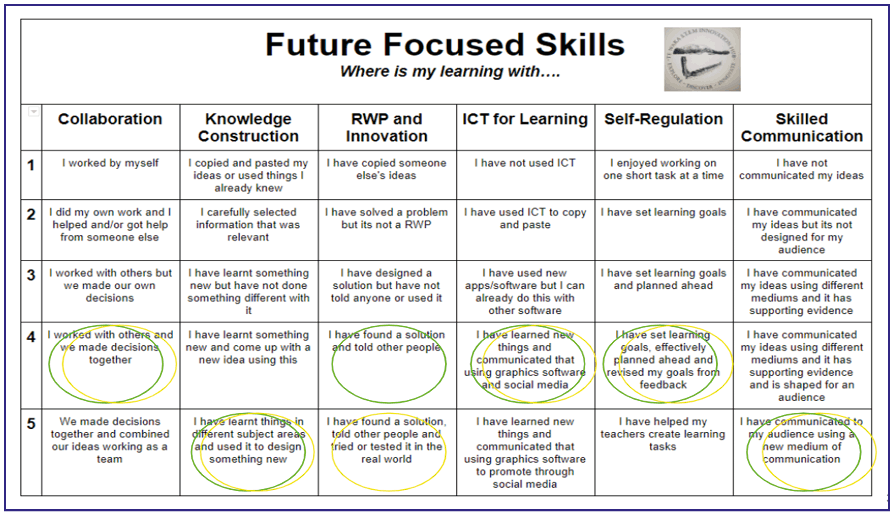
The Future Focused Skills rubric allowed students to self-reflect (in yellow) on their learning at the end of each real world problem. Teachers would then meet with students to give their judgement (in green). The idea of the rubric was for students to aspire to ‘Code 5’ in all future focused skills by the end of Year 10.
1.2 Evidence from Student Survey data
Throughout the two-year project we continuously tried to use student feedback/reflection to improve and gain a sense of engagement and relational pedagogy. During 2020 we used the Evidence Based Education Great Teacher Toolkit survey to collect survey data on student motivation (see below). Consistent with the aims of the initiative, students rated their perceptions of success and determination to succeed mostly highly, although we would still like to see these scores improve. The data also show that there is still some work to do on strengthening students’ perceptions of support from others in the class.
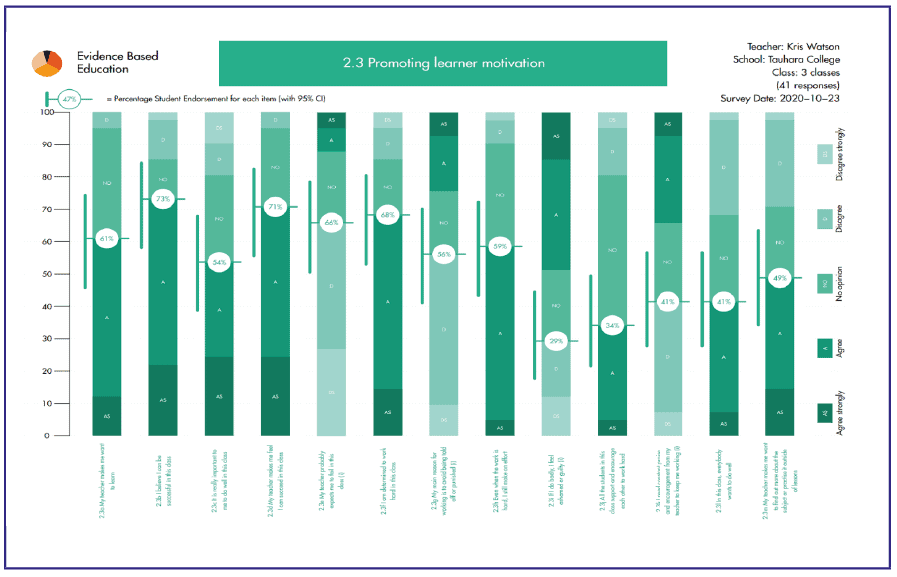
1.3 Student perceptions of mathematics, science and technology – pre and post
In order to assess the impact of the STEAM initiative, we conducted a Google survey repeating a set of questions we had used at the start of the project designed to gauge student perceptions of the value of mathematics, science and technology. The comparative data are shown below, although caution should be taken in interpreting the data because of the significantly different response rates for the pre and post surveys. The strongest positive shifts were in student perceptions of technology, which is perhaps not surprising given that each of the projects had an obvious technology application. While the overall Agree/Strongly Agree score for science did not change, there was a shift away from Strongly Agree to Agree, and this was even more dramatic in mathematics. In spite of engaging in real world problems throughout the STEAM initiative, there was a shift in student perception of their value from Strongly Agree to Agree, although all students continued to affirm the value of this form of work. The shifts show that we may have lost some of the visibility of mathematics and science, and that real world problems are more challenging than students anticipate at the outset.

1.4 Student discussions
At the end of each real world project, both students and teachers carried out an open round table to reflect on the unit. Discussions covered project highlights, what students would change, and whether they would recommend the unit to other students. They also considered what changes could be made to the unit and to teaching and learning approaches to further engage future students. Based on these reflections, changes were made to teaching and learning: some projects were changed and others were replaced with more engaging units of work. Some of the main changes were:
- Introduction of the cross-curricular ePortfolio to centralise evidence of learning and to engage and connect whānau with their child’s learning
- Development STEAM teams, formalising the roles of students to develop collaboration within their areas of strength and possible future career pathways. Teams were also reduced in size from six to three members, each of whom took on two roles.
- Curriculum progress data
2.1 Mathematics
Tauhara College has a school-wide focus on improving multiplicative (NZC L4) and proportional thinking (NZCC L5) at Year 10. Students in the Te Waka STEM Innovation Hub underwent the same standardised testing as their peers, and the graphs below compare the intervention class (10 STEM) with the other classes at Year 10 based on Lomas testing. All classes except for the highest performing class were mixed ability. The 10 STEM students made progress at a similar rate to other mixed ability classes and slightly better progress in multiplicative thinking, which suggests that participating in the integrated units did not disadvantage students mathematically.
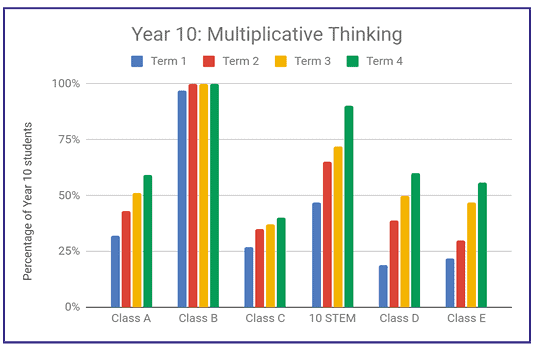

2.2 Science
‘Thinking like a scientist’ assesses students against the sub-strands of the Nature of Science. The data below were collected at the end of Term 2, 2020 across the school’s six Year 10 classes. Apart from the top academic class (Class B), 10 STEM was the best performing mixed-ability class with 65% of students reaching Curriculum level 5p or better.

- Pathways data
3.1 Level 1 NCEA STEM Subjects chosen for 2021
The table below shows that 50% of the Y10 STEM class entering Year 11 studied three or more STEM-based subjects in 2021. Of the original seven Māori girls, six entered Year 11 and 83% went on to study at least two STEM-based subjects.
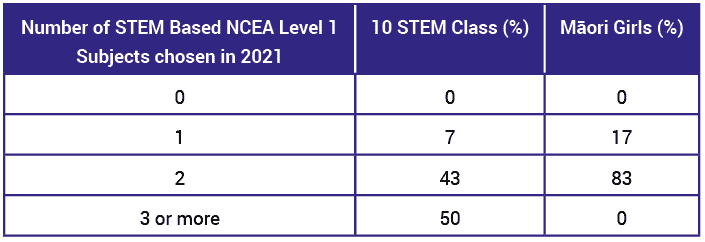
Comments on impact
‘Overall there is a great deal of excitement about this project that is well-deserved. James Lamb, Dan Piper and Kris Watson are to be highly commended for their relentless focus on designing, implementing and sustaining a programme that is a refreshing alternative to the status quo. Overcoming obstacles and shepherding the intent, purpose and momentum of this project has been symbolic of the determination that these three leaders consistently demonstrate’ (Keith Bunting, Principal, Tauhara College, 2019).
‘The beginning of the project saw the three teachers still siloed in their respective learning areas. By the end of the T1 2019 they had changed and were beginning to work as a team. By the end of 2019 the collaboration, resource production, focus was on Design and the journey that each student and each team was taking. 2020 created some extraordinary events. The previous learning about e-portfolio, collaboration, the journey and problem solving, thinking and being creative took over to create engaged, willing, attentive students. It is not an easy process to concede class control and responsibility to students. It is not an easy process to change established pedagogies and implement and normalise a new process. James and Kris achieved this and have driven new approaches to learning. It has been a pleasure to witness this change, contribute and listen to ideas. The Hub has taken on a character of its own, students have become integrated into the purpose, two of the three learning areas have become deeply connected and plans for 2021 have been expanded. 2021 will see more learning areas, more teachers collaborating and some new problems. The Hub will remain located in Year 9 and 10. The data suggests there is similar Learning Area progression for STEAM students but I notice and the data also suggests these students have developed the CCCC (4C’s) to a high level. STEAM is about building a better future and I think this has happened. Thanks to the Ministry of Education for the PLD Funding to support my work’ (Jim Hogan, ACC572, PLD Facilitator).
Student voice:
‘The most important thing I’ve learned this year is the Design Thinking Process because it has helped me understand what goes into making a product, and how to interact with a stakeholder’.
‘This year I have enjoyed STEM as part of my education. The projects we have worked on in the community have helped me to learn how things work in the real world. I enjoy the flexible set-up allowing us to work in more than one room and on the project as we need. Curriculum work could be improved by putting the advanced students onto harder work. I can see this class progressing very well in the future, as STEM can help a lot of students who don’t learn well in a conventional learning environment’.
‘I think the most important thing we have learned is not to give up, even when it goes pear-shaped and you don’t get the results you want, you just have to keep trying’.
Reflections and advice
The following emerged as factors central to the success of the innovation:
- Weekly meetings that allowed for critical reflection and planning, plus several one day workshops offsite allowed for key strategic planning opportunities. Teachers also analysed their own practice using student voice and shared research and readings to improve student outcomes.
- Development of the classroom environment within the Innovation Hub, populated with static image learnings to keep students consistently thinking about the course, context and learning journey. This continues to change to support the class culture and students’ personalities.
- Consistent involvement of community stakeholders and whānau, and initiatives such as Te Waka café, an informal setting for interactions and dialogue that allowed everyone to reflect consistently throughout.
- Development of an ePortfolio for journaling that allows students to utilise ‘Anywhere/Anytime’ learning (which evolved as a result of school closures during Covid19 lockdowns). This also allows students to develop a digital learning journey and captures evidence of learning to support teacher assessment. Google Classroom was used to support student learning in a structured and less overwhelming format (this development came from teacher reflection on student voice).
- Expedition activity sheets (see an example here) allowed for a differentiated learning approach to the curriculum. The expeditions are delivered within the ePortfolio and discussed further in class, allowing students to access learning at both home and school, while enabling them to work through tasks at their own pace. All expeditions follow the Explore, Discover, Innovate theme while supporting and helping students to develop their design thinking skills.
Implementation of the STEM project created some concerns from those staff who considered the traditional subject approach to be more appropriate and who did not have a full appreciation of what was actually happening in the STEM Innovation Hub. This suggests that more needs to be done to explain the approach to colleagues and to help them understand its purpose and impact.
Over the two year duration of the project, we discovered that some units of work were more successful than others. On reflection, the more successful units of work involved:
- Stakeholders who were accessible and readily available
- More hands-on learning opportunities
- Opportunities to explore and discover during offsite field visits
- A higher degree of accountability where presentations and displays involved larger community groups and a non-negotiable deadline
Next steps
Based on our learning over the two years our next steps are as follows,
- Develop the ePortfolio to provide a connection between home and school by using real-time examples of student learning and enable a new reporting system and pathway for student-led conferencing to take place, while allowing evidence of student work across curriculum areas to be demonstrated.
- Further develop staff capacity within the school to enable the programme to include teachers from more curriculum areas, thus creating a truly interdisciplinary approach to teaching.
- Improve student access to appropriate devices and fast internet to support their learning.
- Implement more student voice surveys so teachers can reflect further on ways to improve their practice. The team will work with the Great Teacher Toolkit from Evidence Based Learning alongside Professor Rob Coe from Term 4 2020 onwards.
- Change the name to the Tauhara College STEAM Hub for inclusiveness to reflect the new staff and cross curricular approach in 2021.
- Continue to develop the programme with the formation of STEAM Team Challenges at the end of each unit where students take on the roles of CEOs, engineers and mathematicians to collaborate, arrive at working prototypes for stakeholders, and reflect real world and industry approaches.
Click here to watch the webinar presented by James Lamb and Kris Watson of Tauhara College: Increasing Year 9 and 10 students’ engagement and motivation in STEM subjects
